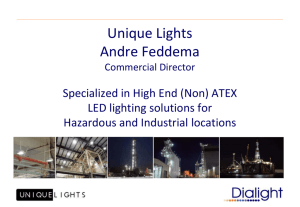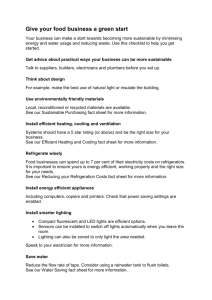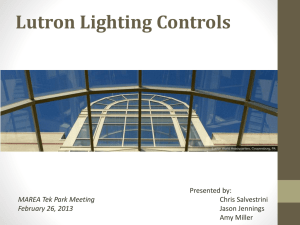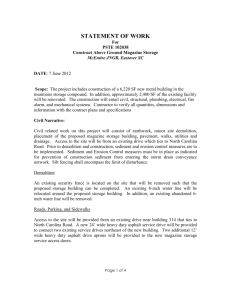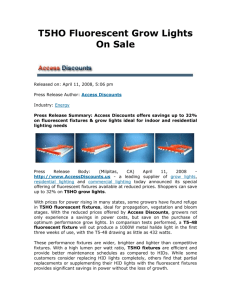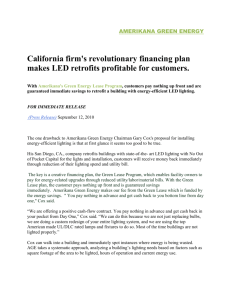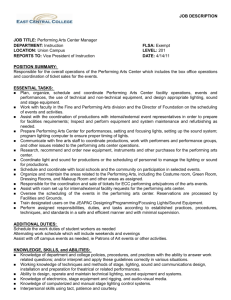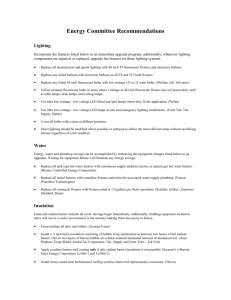Fluorescent & High Bay Lighting Upgrade
advertisement
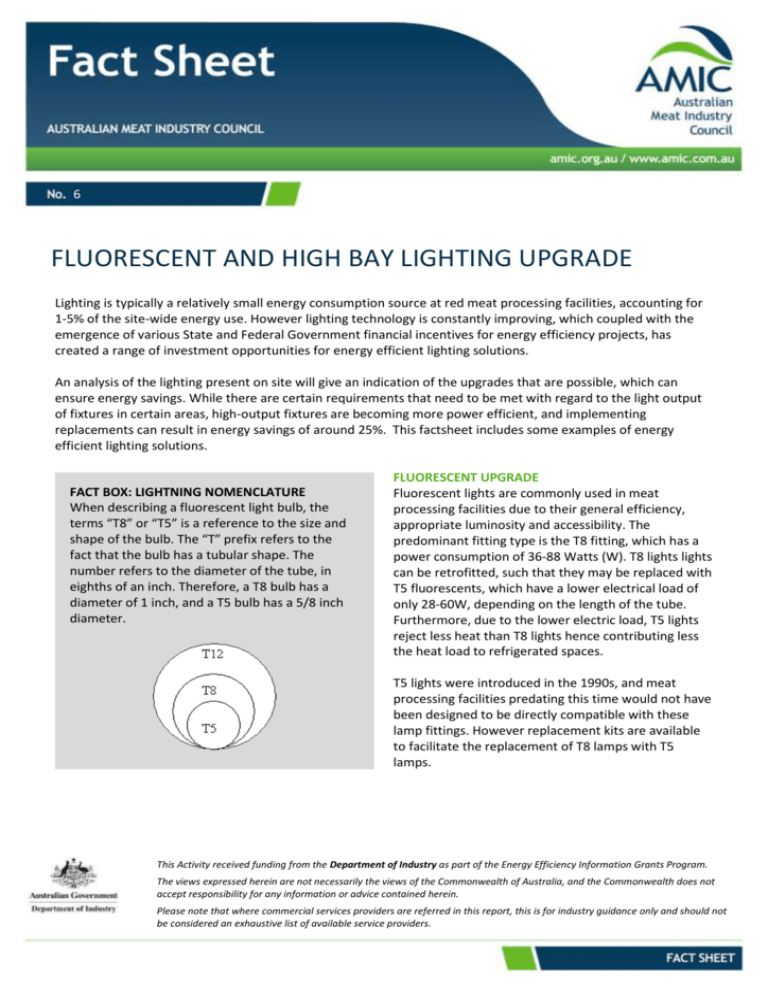
6 FLUORESCENT AND HIGH BAY LIGHTING UPGRADE Lighting is typically a relatively small energy consumption source at red meat processing facilities, accounting for 1-5% of the site-wide energy use. However lighting technology is constantly improving, which coupled with the emergence of various State and Federal Government financial incentives for energy efficiency projects, has created a range of investment opportunities for energy efficient lighting solutions. An analysis of the lighting present on site will give an indication of the upgrades that are possible, which can ensure energy savings. While there are certain requirements that need to be met with regard to the light output of fixtures in certain areas, high-output fixtures are becoming more power efficient, and implementing replacements can result in energy savings of around 25%. This factsheet includes some examples of energy efficient lighting solutions. FACT BOX: LIGHTNING NOMENCLATURE When describing a fluorescent light bulb, the terms “T8” or “T5” is a reference to the size and shape of the bulb. The “T” prefix refers to the fact that the bulb has a tubular shape. The number refers to the diameter of the tube, in eighths of an inch. Therefore, a T8 bulb has a diameter of 1 inch, and a T5 bulb has a 5/8 inch diameter. FLUORESCENT UPGRADE Fluorescent lights are commonly used in meat processing facilities due to their general efficiency, appropriate luminosity and accessibility. The predominant fitting type is the T8 fitting, which has a power consumption of 36-88 Watts (W). T8 lights lights can be retrofitted, such that they may be replaced with T5 fluorescents, which have a lower electrical load of only 28-60W, depending on the length of the tube. Furthermore, due to the lower electric load, T5 lights reject less heat than T8 lights hence contributing less the heat load to refrigerated spaces. T5 lights were introduced in the 1990s, and meat processing facilities predating this time would not have been designed to be directly compatible with these lamp fittings. However replacement kits are available to facilitate the replacement of T8 lamps with T5 lamps. This Activity received funding from the Department of Industry as part of the Energy Efficiency Information Grants Program. The views expressed herein are not necessarily the views of the Commonwealth of Australia, and the Commonwealth does not accept responsibility for any information or advice contained herein. Please note that where commercial services providers are referred in this report, this is for industry guidance only and should not be considered an exhaustive list of available service providers. Example A meat processing site contains 139 twin T8 fittings, which operate up to 15 hrs/day. Plant management is considering replacing the T8 lamps with T5 lamps and fittings, which consume less energy (~60W as opposed to ~88W). The total energy savings possible are around 15 MWh per year, at a cost of $11,815. The annual cost savings would be $2,797, providing a 4.2 year payback period. FACT BOX: HIGH BAY LIGHTING High bay lighting is generally defined as any interior lighting, where the roof truss or ceiling height is more than 5 m above the floor. Energy reduction Lamp life [hours] Watts Lumens Typical payback HIGH BAY LIGHTING UPGRADE High bay lighting needs are typically satisfied by metal halide fixtures, often around 400 W each. These lights consume 454 W (including the lamp and ballast load) and deliver 36,000 lux. There are several more efficient options on the market, including 320 W pulse start metal halides, 300 W induction and 150 W LEDs, with similar light output and less energy input. 320 W pulse-start metal halide 150 W LED luminaire 300 W induction lamp 20% to 30% 32,000 349 31,000 4 to 5 years 40% to 60% 50,000 226 14,580 >5 years 30% to 40% 60,000 320 26,000 >5 years Example A meat processing site has 88 x 400W metal halide high bay fixtures, both vertical and horizontal. By replacing these all with 320W pulse start metal halides at a project cost of $29,920, a 23% electrical saving is estimated, amounting to 34 MWh. This represents a financial saving of $6,321 per year and a 4.8 year payback period.


